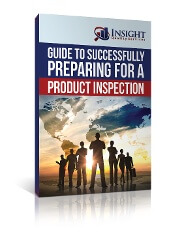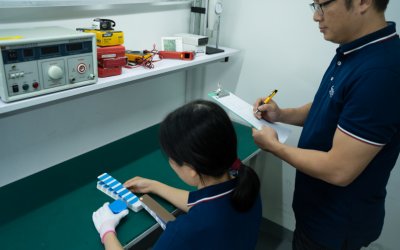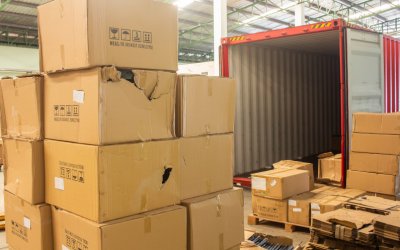Of course, your packaging needs to be in line with Amazon’s guidelines. But, more than that, it needs to survive the journey from your Chinese factory to Amazon’s warehouse.
Have you ever watched videos of airline baggage handlers on Youtube? The ones where they throw suitcases around as if they were playing catch in the backyard?
Then, oops, a suitcase gets dropped.
You may not realize it, but it’s very possible your FBA product will be treated in a similar way during transportation.
Let’s talk about the journey that your product goes on from China to the US. Then we’ll talk about how to ensure your packages and products make it to Amazon unharmed.
This is Your Product’s Long and Harrowing Journey
Let’s take a look at the typical journey your product will go on:
Step 1: The journey often begins at the workshop or subcontracted factory where your product is made. Often times, the company you work with does not make it on site.
Step 2: Your package goes to the main factory or trading/export company you’re working with.
Step 3: Then it’s on to the local warehouse for loading.
Step 4: Once loaded, it travels to the port in China.
Step 5: Generally, Amazon sellers purchase less-than-container loads (LCL). So, once it’s at the port, it gets loaded into a container with other products.
Step 6: Your container is moved onto the ship which will take it to the USA.
Step 7: The ship spends 2 or more weeks navigating ocean waters until it arrives at the US port.
Step 8: The containers are unloaded at the port.
Step 9: Your product is put onto a truck and sent to different warehouses. It may be sent to 4 or 5 different distribution centers before it reaches the final destination. The number of warehouses depends on the transportation distance.
Step 10: Your packages arrive at the final destination.
As you can see, there are quite a few steps in this process. You should keep in mind that every step is an opportunity for your packages to get dropped, punctured, or generally mistreated.
The container can also move around a lot. That’s why it’s important to ensure your product is packaged properly. How do you do that?
5 Tips to Help Ensure That Your Packages Survive
When thinking about how to protect your product and package, you should consider the strength of your box and the packaging materials you use. You should also consider quality tests to verify their strength.
Here are 5 tips to keep in mind:
Tip #1 – Burst Strength is Key
Often times, when an importer realizes that their box isn’t strong enough, they switch to one with more layers. This helps, but the most important thing is to choose a box with sufficient burst strength.
Burst strength measures the box’s resistance to rupturing. It’s measured in pounds per square inch (PSI). The higher the burst strength, the stronger your box is. For significant protection, we recommend using a box with a burst strength of 200 PSI.
Tip #2 – Shipping on Pallets
If your product is heavy, you may want to use pallets for shipping. Palletization helps eliminate some of the manual handling involved. It makes your cartons easier to move and less likely to get damaged.
When the product is loaded onto the pallet, it should be wrapped with stretch film. The cost of palletizing is higher than not doing so. But during shipping, it will be kept up off the ground to protect it from moisture and is less likely to be mishandled.
Tip #3 – Stacking Tests
Stacking tests let you know whether your cartons can withstand weight from above. Because most FBA sellers are purchasing less-than-container loads (LCL), you can’t be sure about what gets stacked on top of your cartons in the container. If those cartons are heavy, they can crush your packages beneath them.
In a stacking test, 5 or 6 cartons are piled on top of each other. After 12 or 24 hours, the cartons are checked to see if they withstood the pressure. If there is damage after 24 hours, then after 2-3 weeks in transit, you can bet there will be even more.
Tip #4 – Carton Drop Tests
Carton drop tests are a way of determining how your cartons will fare if they are dropped during handling. They will be dropped from a specific height based on ISTA standards. They’ll be dropped on the corners, edges, and faces of the box.
A carton drop test is most valuable on your first shipment. It can help you to be sure you’re on the right track with your packaging. Of course, the trade-off is the cost involved if conducted by a lab but your inspection service can conduct during your pre-shipment inspection.
Tip #5 – Vibration Testing
Vibration tests are less common but are quite interesting. Vibration testing helps simulate the movement that your box might go through during transport. It will be thrown forward backward and to the sides as if it was in a truck driving down a bumpy road.
Few large factories have this capability, so it is something you can always ask about but generally would require testing through a lab.
Weighing the Costs and Benefits of These Options
As an Amazon seller, you’re probably very concerned about minimizing costs. There’s always a trade-off between doing drop, stacking tests, or vibration tests and the added expense.
At a minimum, you should consider choosing a box that has a 200 PSI burst strength. This basic step can go a long way toward making sure your packages get to Amazon’s warehouse in good shape.
How to Prepare for a Quality Inspection
Download this free guide to successfully preparing for your product inspections.





0 Comments